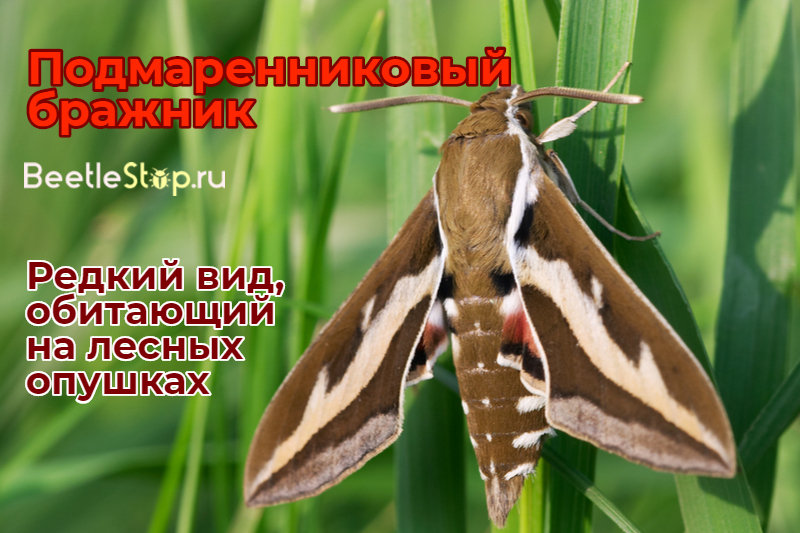Strawberry Hogweed: features of the species listed in the Red Book
The common brassica butterfly lives everywhere where there are many flowering herbaceous plants. Adults and caterpillars of this species feed on weed perennials. The phytophage is safe for crops, gardens and vegetable gardens. Years of butterflies are observed in the evening or early in the morning from May to October. Eating nectar, insects hover over the flower like a hummingbird.

View description
The adults of the saffron coddler are distinguished by their large size - the wingspan of the male is 65-70 mm, the females - 70-75 mm. Their thick body is densely covered with hairs. The thoracic section is olive brown. Antenna fusiform, green or gray, white at the tips. Fore wings narrow, olive green with a longitudinal light stripe in the central part. The hind wings are pink or yellow with a wide black border around the edge. Transverse white stripes on moth’s belly.
Interesting fact. The color intensity of the butterfly depends on humidity. In arid areas, the hawks are pale, while the cool and humid regions are darker.
Eyes of the facet type, convex and round, covered with scaly eyebrows from above. The oral apparatus is represented by a long proboscis. The insect flies very fast; in flight it emits a characteristic buzz associated with flapping wings.
The caterpillar is dark olive in color with a light stripe along the entire back. On each segment of the body there is a black stripe and a large white spot of a rounded shape. Head and horn-shaped outgrowth at the posterior end of red. The lower body is pinkish.
The body of the caterpillar is bare, reaches a length of 80 mm. Larvae have 8 pairs of legs. With the onset of frost, they begin to search for a place to pupate. Pupa red-brown, 40 mm in size. Winters in the litter.
Interesting fact. An alarmed caterpillar raises the front of the body and freezes in a threatening pose. For this feature they were nicknamed the Sphinxes.
Food
What does the caterpillar of the bedstraw shredder eat? The diet of the larva consists of herbaceous plants - bedstraws. These are wild herbs, many of which are harmful weeds. By destroying them, the insect benefits. In addition to madder hornbeam settles on the plantain, Ivan - tea, milkweed, geraniums. Caterpillars eat ruderals - weed plants grown in landfills, roadsides.
Spread
Hybridis (Hylesgallii) is widely distributed throughout the European part of Russia, in North America, Siberia and the Caucasus. It is found in Japan, China, in northern India, everywhere in the Far East. Insects live on the edges of deciduous and mixed forests, on glades and clearings. They are found in coastal and subalpine mixed meadows, along railways and highways, sometimes in populated areas.
Life cycle
The length of life of insects is small - 30-45 days. Two generations of butterflies manage to appear during the season:
- the first is June — July;
- the second is August — September.
Butterflies appear in the summer, they exist at the expense of the nutrients accumulated by the caterpillar and additionally feed on nectar. I fly in the evening, at night, striving for a source of light, fly several kilometers. In flowers, moths feed and mate. The process continues for two hours.After fertilization, the female lays single round eggs on the back of the leaves of the feed plant. You can see them near the flowers. Masonry lasts up to 10 days.
Representatives of the Lepidoptera family undergo a complete transformation cycle:
- egg;
- larva (caterpillar);
- pupa;
- butterfly.
The eggs are green, similar to small peas with a diameter of 1 mm. After 7-20 days, depending on the temperature on the street, small caterpillars of the first age appear from them. Hatching larva is light green with several longitudinal yellow lines. Its size is about 3-4 mm. The young caterpillar eats day and night, with small intervals for rest. With each molt, its length increases, and the color becomes darker.
The caterpillar of the last age acquires a black color. Her head and horn are dark red. The insect survives the winter at the pupal stage. Colds are experienced in a cocoon of fallen leaves and silk threads, hiding in moss or in small indentations up to 5 cm. New butterflies appear in early summer.
Conservation status
Strawberry Hogweed is listed in the Red Book of Kamchatka. The number of species has decreased significantly due to human activities. Among the negative factors inhibiting population growth:
- rainy weather while feeding butterflies;
- early frosts;
- natural enemies;
- grass fell, leading to the death of the pupae.
The appearance of such an insect on the site is very rare. Butterfly and caterpillar will not cause harm to plants, and watching a rare species in the natural environment is very exciting.


 (votes: 12, average rating: 4,25 out of 5)
(votes: 12, average rating: 4,25 out of 5)